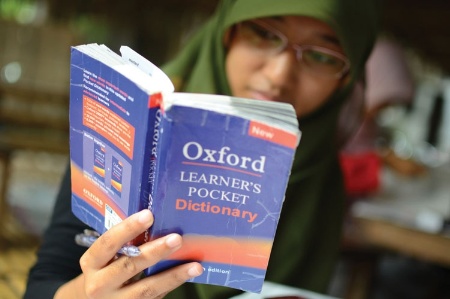Source: Getty
A bridge too far: multiple languages and a widely dispersed population mean the Indonesian Ministry of Education has a ‘tough job these days’ to distribute education evenly
When Christine Ennew, currently provost of the University of Nottingham’s Malaysia campus, visited Indonesia at the start of the new millennium, she felt “decidedly uncomfortable”.
General Suharto, whose three-decade dictatorship had been marked by the massacre of opponents and widespread corruption, but also by rapid economic growth, had been forced from office by protests two years earlier. There was therefore a tension in the air, and Indonesia struck Ennew as “economically very disadvantaged”.
Ten years later, however, she returned to find a far more optimistic country. There was a “vastly improved infrastructure, less poverty, a much greater sense of vibrancy”, she recalls. “It felt like a place that was really starting to motor.”
This observation applies to higher education as well as it does to the economy as a whole: between 2005 and 2012, the number of graduates in the country doubled, according to a briefing on Indonesia’s education system released by the British Council in May this year.
UK universities have traditionally had much stronger links with other countries in the region, such as Malaysia, a former British colony. Now, however, they are beefing up their ties with Indonesia (after much encouragement from the British government).
In November last year, David Willetts, the universities and science minister, signed an agreement with his Indonesian counterpart that struck up eight new partnerships between UK universities and the most highly regarded Indonesian institutions.
Cranfield University and Institut Teknologi Bandung (ITB) are creating a double-degree master’s programme in engineering and technology, for example, while Newcastle University and Universitas Indonesia will establish a doctoral training centre.
They certainly have their work cut out. There seems to be relatively little independent outside scrutiny of Indonesian higher education, either by Western journalists or by global bodies such as the World Bank, but the few pieces of comparative analysis that exist do not paint a rosy picture.
Indonesia finished bottom out of 50 countries in the 2013 edition of the Universitas 21 ranking, which grades national higher education systems on investment, research output, gender balance, international connectivity and other measures (it scored particularly badly on the first two metrics).
Despite the doubling of graduate numbers between 2005 and 2012, the enrolment rate for tertiary education – 22 per cent for women and 24 per cent for men – still lags behind much of the rest of the region, according to the British Council report.
Coming up
And waiting in the wings is a huge new generation approaching university age. Out of Indonesia’s population of nearly quarter of a billion (the fourth largest of any nation), about 72 million are under the age of 14, according to World Bank statistics. The country will gain 250,000 more 15- to 19-year-olds between 2013 and 2014, the British Council report predicts.
“In 20 to 30 years from now, these people will be running the country,” says Fauzi Soelaiman, educational attaché at the Indonesian Embassy in London. And if they are not properly educated, the country will suffer. “The job for the Ministry of Education is very, very tough these days,” he adds.
Its task is made even more difficult by the country’s geography. Indonesia is an archipelago of more than 17,000 islands, which makes it “hard to distribute education evenly”, Soelaiman explains. More than 700 different languages are thought to be spoken across the country.
Indonesia was not occupied by the British but was colonised by the Dutch instead, and so “English is not our second language”, Soelaiman says.
The lack of fluency in higher education’s emerging lingua franca has thwarted the government’s attempts to send Indonesian students abroad to earn PhDs. Of the country’s estimated 220,000 lecturers, fewer than half have doctorates, Soelaiman explains. Thirty years ago, he taught undergraduates himself – despite possessing only a BA at the time.

In 2008, the government set a target of 5,000 Indonesians completing PhDs each year. “We could not match that,” he admits.
Scholarships were set aside to send about 2,000 students a year overseas, including some to the UK. But only half were taken up because not enough applicants were proficient in English, he laments. “The money is there. The problem is the people.”
Soelaiman would like to spend more on English language courses for potential doctoral candidates, but the law does not allow scholarship money to be used on non-degree courses, he explains.
Ennew concurs that a lack of money is not the primary obstacle to building a stronger Indonesian faculty. “Funding is not a major consideration. It’s not like Bangladesh or Ethiopia,” she says.
Another problem is that young academics normally teach for three to four years with a master’s degree before they embark on their PhDs, she explains, by which time they often have a spouse and children. However, the doctoral scholarships do not provide any support for students’ families, making relocation difficult.
As a consequence “there’s definitely a bottleneck” hampering the improvement of Indonesian higher education, says Lily Manoharan, director of internationalisation at Binus University in the capital, Jakarta.
To get around this problem, Binus has been hiring foreign faculty, and it aims to have 60 per cent of its courses taught in English by 2020, she explains.
But Manoharan doubts that less prestigious private institutions – of which there are about 2,500, compared with some 80 state universities – will be able to make the switch to English. Even if they could, she adds, they would struggle to afford to hire foreign lecturers. “Local institutions…find it challenging hiring qualified faculty for existing programmes,” she says.
The training track
Not everyone sees that as the most pressing problem. As Soelaiman explains, the Indonesian government is more interested in expanding vocational courses than it is in funnelling youngsters into a traditional academic route. “We want people with skills rather than PhDs,” he says.
The government has committed to building 500 community colleges over the next five years. These will offer vocational courses in cookery, electrical installation, hairdressing and other skills, he explains, arguing that Indonesia’s job market will simply not support a flood of graduates with more academic qualifications.
Although Indonesia is setting up a new generation of technological universities, nurtured by established institutions such as ITB, Soelaiman emphasises that the country is trying to build up the middle of its educational pyramid, not just the highly qualified top.
Some employers might disagree with this approach. A report by Boston Consulting Group, released in May, warns of Indonesia’s “looming talent shortage”. Administrative and managerial jobs, it pointed out, will account for more than half of all employment by 2020, up from 38 per cent today.
“Indonesia is not producing nearly enough graduates to fill these positions, and few of today’s graduates are sufficiently qualified,” says the report, Tackling Indonesia’s Talent Challenges: Growing Pains, Lasting Advantage.
Attempts to address all these challenges often run into a common problem: bureaucracy. Ennew has encountered a fair number of “bureaucratic difficulties” when trying to strike up links with Indonesia’s universities, whose response, she says, is often: “Well, it’s a nice idea, but we can’t do it.” The system has “quite clear rules about what [degree courses] should look like”, she adds.
This certainly tallies with Times Higher Education’s experience of Indonesian bureaucracy when trying to obtain a journalist visa to visit the country’s universities. A first application, presented almost four working weeks before the visa was required, was sent back because it failed to list every meeting planned for the visit. In the end, THE had to cancel its visit because Indonesia’s Ministry of Information failed to approve the visa in time.
If Indonesia’s universities respond to its burgeoning young population with such sluggishness, the country’s “demographic dividend” could turn in to a demographic time bomb.
Register to continue
Why register?
- Registration is free and only takes a moment
- Once registered, you can read 3 articles a month
- Sign up for our newsletter
Subscribe
Or subscribe for unlimited access to:
- Unlimited access to news, views, insights & reviews
- Digital editions
- Digital access to THE’s university and college rankings analysis
Already registered or a current subscriber?




